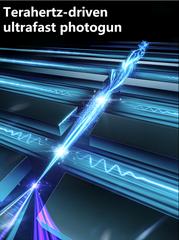URL: https://www.desy.de/news/news_search/index_eng.html
Breadcrumb Navigation
DESY News: Introducing: the first practical Terahertz-powered ultrafast photogun
News
News from the DESY research centre
Introducing: the first practical Terahertz-powered ultrafast photogun
A team of researchers from the Shanghai Jiao Tong University, DESY and Universität Hamburg have developed the first practical Terahertz (THz)-driven photogun. Electron guns enabling ultrashort and -bright electron bunches have recently lead to the implementation of ultrafast electron diffraction instruments as a complementary technology to X-ray free-electron lasers for determining the structure and function of atomic, molecular and nano-systems on their intrinsic timescales.

The short THz driving pulses enabled a peak acceleration gradient of up to some three GV/m, leading to electron beams with energies reaching around 14 keV, a minimal energy spread and exceptional beam quality with only about 0.02 mm mrad transverse emittance. By integrating a rebunching cell, the scientists managed to compress the electron bunch by about 10 times to a duration of 167 femtoseconds, enhancing its utility for ultrafast applications.
The study also demonstrated the practical applicability of the technology by producing high-quality diffraction patterns of single-crystal silicon and projection microscopy images of a copper mesh, opening up new possibilities in electron projection microscopy and diffraction. Additionally, the researchers were able to map transient radial electric fields on the copper mesh with high spatiotemporal resolution, offering a potential avenue for plasma-based beam manipulation.
Published in Nature Photonics, this research represents the highest energy, acceleration gradient, and beam quality reported thus far from an all-optical THz-powered device, promising exciting prospects for future implementations in tabletop radiation sources and other research areas.
Original publication
"High gradient Terahertz-driven ultrafast photogun", J. Ying, X. He, D Su, L. Zheng, T. Kroh, T. Rohwer, M. Fakhari, G. Kassier, J. Ma, P. Yuan, N. H. Matlis, F. X. Kärtner and D. Zhang, Nature Photonics (2024); DOI: 10.1038/s41566-024-01441-y



